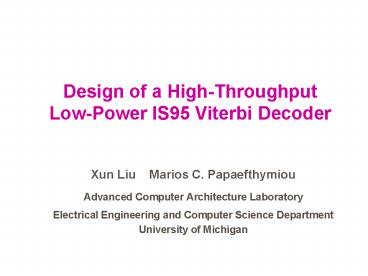Design of a HighThroughput LowPower IS95 Viterbi Decoder - PowerPoint PPT Presentation
1 / 34
Title:
Design of a HighThroughput LowPower IS95 Viterbi Decoder
Description:
Construction of a complex graph called trellis. Computation of the shortest path. IS95 VD Trellis. 256 nodes # of symbols. 1. 2. 3. 4. Challenge of Large-State VD ... – PowerPoint PPT presentation
Number of Views:71
Avg rating:3.0/5.0
Title: Design of a HighThroughput LowPower IS95 Viterbi Decoder
1
Design of a High-Throughput Low-Power IS95
Viterbi Decoder
- Xun Liu Marios C. Papaefthymiou
- Advanced Computer Architecture Laboratory
- Electrical Engineering and Computer Science
Department - University of Michigan
2
(No Transcript)
3
(No Transcript)
4
IS95 Convolutional Encoding
- Used in the reverse link of IS95 CDMA system
- 256 states (8 state registers)
- Rate 1/3
- Maximum Free Distance coding
5
Viterbi Decoding (VD)
- VD is optimal for convolutional codes.
- Maximum likelihood decoding scheme.
- Minimum error for additive white Gaussian noise
channel. - VD procedure.
- Construction of a complex graph called trellis.
- Computation of the shortest path.
6
7
Challenge of Large-State VD Designs
- High computational complexity.
- VDs with hundreds of states require multiple Gops
throughput, when symbol transfer rates reach
Mbps. - Parallel processing.
- High interconnect power dissipation.
- Complex routing among the processors.
For large-state VDs, global data transfer and
interconnect issues must be considered carefully
8
Viterbi Decoder Designs
9
Presentation Outline
- Viterbi decoding overview
- Our contributions
- Data transfer oriented hierarchical
inter-processor optimization - Intra-processor power optimization
- Chip data
10
Encoding Example
11
Viterbi Decoding
12
(No Transcript)
13
(No Transcript)
14
VD Summary
- Each decoded symbol requires a layer of similar
computations - 2N edge weight computations (N of states).
- N add-compare-select (ACS) operations.
- Operations within each layer are independent.
15
Viterbi Decoder Architectures
Design space number of processors used
16
Viterbi Decoder Architectures
Design space number of processors used
Intermediate solutions
17
Key Issues
- How many ACS processors?
- Which ACS operations are executed in each
processor? - Which ACS operations can be executed
concurrently? - In what order are the operations executed?
- Can processors be pipelined?
18
Q Which operations are executed in each ACS
processor?A Operation partitioning for global
data transfer reduction
19
Operation Partitioning Example
20
Operation Partitioning Results
- Obtain solution by iterative bi-partitioning
(KL). - For 64 partitions, gt50 data transfers are
global. - Largest absolute reduction 4 to 32 partitions.
21
Q Which operations are executed
simultaneously?A Operation packing for global
bus minimization
22
Operation Packing Example
0
2
2
0
23
Operation Packing
- Packing procedure for global bus minimization
- One operation from each partition in each slice
- Global data transfers within a slice done
simultaneously - Bus cost the number of ACS units connected
- Our heuristic
- Distribute global transfers evenly in all slices
24
Operation Packing Results
- Comparison solution one bus between any two ACS
processors - Global buses reduction 31 on the average
- Most effective range 8 to 32 partitions
25
Q In what order should operations be executed?
Q Can ACS units be pipelined? A
Non-forwarding scheduling
26
Non-forwarding Scheduling
27
Non-forwarding Scheduling Results
- Greedy heuristic
- Pick slice with the least dependencies first.
- Iteratively pick the next slice such that the
upper bound of the non-forwarding pipeline depth
derived by the chosen slices is maximized.
- Architectures with 16 or more parallel processors
allow very limited non-forwarding pipeline depth.
28
Q How many ACS processors should be used?
29
Viterbi Decoder Architecture
30
Processor Internal Architecture
- 16-bit datapath
- 8 pipeline stages
31
Processor Level Power Reduction
- Combine precomputation and saturation arithmetic.
- If one or two operands overflow, ACS is partially
shut off. - No significant degradation of the decoding
performance.
32
Chip Implementation
- Design RTL Verilog
- Synthesis Design Analyzer
- Placement manual floorplan
- Routing Silicon Ensemble
- Verification gate level Verilog
- Power estimation Primepower
33
Chip Summary
34
Conclusion
- Design case study of a 256-state IS95 VD
- Hierarchical optimization methodology
- Global data transfer minimization
- Global bus reduction
- Non-forwarding scheduling
- Precomputation and saturation arithmetic
- Viterbi decoder
- 8 pipelined processors
- 4 global buses
- Throughput 20Mbps
- Power dissipation 450mW































